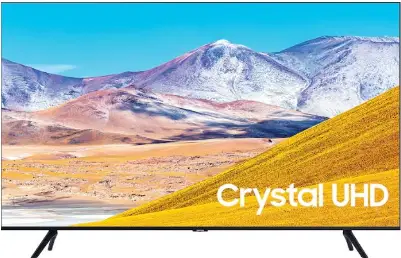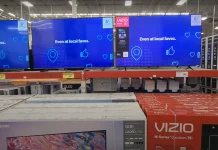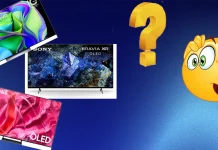The Samsung TU8000 series televisions, introduced in 2020, are featured on the official North American website. Let’s explore the changes Samsung made to its 8000 series in 2020.
Samsung 8 Series: TU8000, RU8000, and NU8000
In the United States, the TU8000 series is available under the following model numbers:
- UN43TU8000FXZA
- UN50TU8000FXZA
- UN55TU8000FXZA
- UN65TU8000FXZA
- UN75TU8000FXZA
In Europe, the model numbers are:
- UE43TU8000UXXU
- UE50TU8000UX
- UE55TU8000UX
- UE65TU8000UX
- UE75TU8000UX
The last two characters of the European model numbers may vary depending on the country of manufacture.
Comparison of the Samsung 8000 Series TVs (2018-2020)
| TU8000 (2020) | RU8000 (2019) | NU8000 (2018) | |
| screen | |||
| Screen Size | 43, 50, 55, 65,75 | 43, 50, 55, 65,75, 82 | 43, 50, 55, 65,75 |
| Style | Flat Panel | Flat Panel | Flat Panel |
| Resolution | 3,840 x 2,160 | 3,840 x 2,160 | 3,840 x 2,160 |
| screen bit | 10bit (8bits+FRC) | 10bit (8bits+FRC) | 10bit (8bits+FRC) |
| type screnn | Crystal UHD | premium | premium |
| screen technology | VA | VA | VA |
| Backlighting | Edge-LED | Ultra Slim Array (Edge) | Edge-lit LED |
| Dimming Technology | ? | UHD Dimming | Supreme UHD Dimming |
| Stand Type (Color) | Slim Feet (Black) | Flat Foot Simple | T-Type Center Low |
| Bezel Width | Slim | SNB | 3 Bezel-less |
| Video | |||
| Motion Rate | 120 | 240 | 240 |
| refresh rate | 60 | 120 | 120 |
| Color | PurColor | Dynamic Crystal Color | Dynamic Crystal Color |
| HDR (High-Dynamic Range) | HDR | HDR | HDR Plus |
| Picture Engine | Crystal Processor 4K | UHD Engine | UHD Engine |
| Audio | |||
| Dolby | Yes | Yes | Yes |
| Sound Output | 20W | 20W | 40W |
| Woofer | No | No | Yes |
| Speaker Type | 2.0CH | 2CH | 2.1CH |
| Multiroom Link | Yes | Yes | Yes |
| Features | |||
| OS | Tizen | Tizen 5.0 | Tizen 4.0 |
| Wi-Fi | Yes | Yes | Yes |
| Bluetooth | Yes (ver.4.2) | Yes (ver.4.2) | Yes (ver.4.2) |
| Smart Hub | Yes (incl. Universal Guide and TV Plus) | Yes (incl. Sports, Music and TV Plus) | Yes (incl. Sports, Music and TV Plus) |
| Bixby | Yes | Yes | Yes |
| Digital Clean View | Yes | Yes | Yes |
| Ultra Black | No | No | No |
| ConnectShare | Yes | Yes | Yes |
| Closed Captioning | Yes | Yes | Yes |
| Game Mode | Yes | Yes | Yes |
| Eco Sensor | Yes | Yes | Yes |
| Mobile to TV – Mirroring, DLNA | Yes | Yes | Yes |
| Google Assistant | Yes | Yes | No |
| Alexa | Yes | Yes | No |
| Auto Channel Search | Yes | Yes | Yes |
| InstaPort S (HDMI Quick Switch) | Yes | Yes | Yes |
| Channel Guide | Yes | Yes | Yes |
| Ambient Mode | Yes | No | No |
| Auto Power Off | Yes | Yes | Yes |
| AI Technology | No | No | No |
| Apps Platform | Smart TV Powered by TIZEN™ with Bixby Voice, Apps and Full Web Browser | Smart TV with Bixby Voice, Apps and Full Web Browser | Smart TV with Bixby Voice, Apps and Full Web Browser |
| Auto Motion Plus | Yes | Yes | Yes |
| Embedded POP | Yes | Yes | Yes |
| Anynet+ (HDMI-CEC) | Yes | Yes | Yes |
| V-Chip | Yes | Yes | Yes |
| TV to Mobile – Mirroring | Yes | No | Yes |
| USB HID Support | Yes | Yes | Yes |
| AI Upscale | No | No | No |
| Easy Pairing | No | No | Yes |
| Inputs & Outputs | |||
| HDMI | 3 | 4 | 4 |
| USB | 2 (ver 2.0) | 2 | 2 |
| Ethernet | Yes | Yes | Yes |
| RF In (Terrestrial/Cable | Yes | Yes | Yes |
| RF In (Satellite Input) | No US, Yes Europe | No US, Yes Europe | No US, Yes Europe |
| Digital Audio Out (Optical) | Yes | Yes | Yes |
| Audio Return Channel Support | Yes | Yes | Yes |
| One Connect | No | No | No |
| Dimensions | |||
| Digital Broadcasting US | ATSC/ClearQAM | ATSC/ClearQAM | ATSC/ClearQAM |
| Digital Broadcasting Europe | DVB T/T2/C/S/S2 | DVB T/T2/C/S/S2 | DVB T/T2/C/S/S2 |
| Analog Tuner | Yes | Yes | Yes |
| Accessories | |||
| Remote control | Standard Smart Remote (TM2050A) | TM1950A | TM1850A |
Features and Differences in the TU8000 Series
In 2020, Samsung rebranded its 8 Series TVs as Crystal UHD. Before this, they were referred to as the Premium Series. A key change in the technical specifications is the screen refresh rate—TU8000 models now support a frame rate of 60Hz, whereas 2019 models had better 120Hz refresh rates. The TU8000 series also uses an edge-lit screen. Additionally, the number of HDMI ports has been reduced to 3, compared to previous models with more ports.
There are minimal other changes. The processor is now called the Crystal Processor 4K, though this seems to be the same processor used in Samsung’s 6 Series TVs in previous years, given the reduction in HDMI ports and the 60Hz refresh rate. Most other specifications remain consistent with those of earlier models.
A Shift in Series Classification
In 2020, Samsung significantly reduced the differentiation between its TV series. The TU8000 series, in particular, cannot truly be considered an “8 Series” TV, especially in North America, as it lacks many of the premium features typically associated with the 8 Series. This shift marks a departure from the traditional segmentation of Samsung’s TV lineup.






